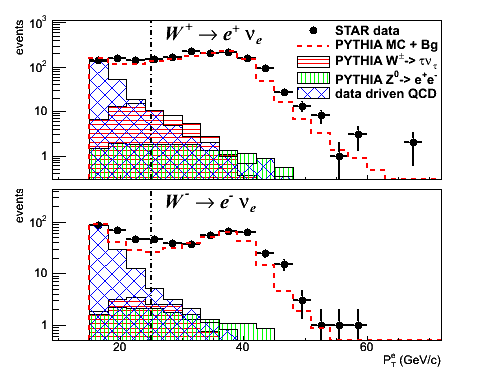W Tranverse paper proposal
Measurement of the transverse single-spin asymmetry for weak boson production in polarized proton-proton collisions at RHIC
Target journal: Physical Review Letters
PAs: Salvatore Fazio, Dmitri Smirnov, and Elke-Caroline Aschenauer
Power Point presentation: HERE
abstract:
We present the measurement of the transverse single-spin asymmetry of weak boson production in transversely polarized proton-proton collisions at sqrt(s) = 500 GeV by the STAR experiment at RHIC. The measured observable is sensitive to the Sivers function, one of the transverse momentum dependent parton distribution functions, which is predicted to have the opposite sign in protonproton collisions from that observed in deep inelastic lepton-proton scattering. These data provide the first experimental investigation of the non-universality of the Sivers function, fundamental to our understanding of QCD.
TABELS OF RESULTS
PAPER JUSTIFICATION - for PRL editors
Figures
Figure 1
Figure 2
Figure 3
.png)
Transverse single spin asymmetry amplitude for W+-/Z0 boson production, the 3.4% overall systematic uncertainty due to beam polarization is not included
Figure 4
.png) Important conclusions for STAR members
Important conclusions for STAR members
Before the present work it was commonly believed that at the STAR detector, due to the limited tracker acceptance of pseudo-rapidity ∼ 1, the missing transverse momentum of the produced boson could not be reconstructed from the the hadronic recoil because particles with high rapidity escape the detector. This assumption did not account for the fact that proton remnants with high longitudinal momentum carry away only a little portion of the total transverse momentum.
The present analysis, based on a pilot run on 25 pb-1, is a proof-of-principle study which shows that the acceptance of the STAR detector is large enough to allow for a full reconstruction of W boson kinematics with Pt > 1 GeV. This was possible following a well known procedure previously used at Tevatron and the LHC. This method is two-fold: on a first step the boson Pt is reconstructed applying a Monte Carlo based correction to the data and on a second step the longitudinal component of the momentum is reconstructed solving the quadratic equation for the invariant mass of the produced boson.
The present STAR result is the world first measurement of the transverse single spin asymmetry for fully reconstructed weak bosons and will compete with Drell-Yan measurements for a first direct experimental test of color interactions in QCD based on measuring the universality breaking of the quark Sivers’ function in SIDIS and Drell-Yan (or weak boson production) process following from the fundamental prediction of gauge invariance in QCD. The verification of this universality breaking, the much discussed "Sivers' sign change", is acknowledged as an NSAC performance milestone for hadron physics.
STAR is the only experiment capable of measuring AN for direct photons, for W± and Z0 bosons, and possibly for DY, providing a world-wide unique opportunity to simultaneously test TMD evolution, access the Sivers function for sea quarks, and test the predicted sign-change for the Sivers function.
Paper conclusions
This measurement is based on a data set of transverse polarized p+p collisions at √s = 500 GeV with a recorded integrated luminosity of 25 pb−1. The results can lead to the first experimental test of the non-universality of the Sivers' function and provide a direct verification of the TMD evolution. Furthermore, it provides an ideal tool to study the spin-flavor structure of sea quarks inside the proton. The coupling of the W boson to the weak charge correlates directly to quark flavor. Ignoring quark mixing, W± bosons are produced through u+d-bar (d +u-bar) interactions. A measurement of the AN of weak bosons provides an ideal tool to study the spin-flavor structure of light quarks inside the proton, in an x-range where the measured asymmetry in the u-bar and d-bar unpolarized sea quark distribution can only be explained by strong non-pQCD contributions.
Recent presentations
Spin PWG, Aug 6th 2015 - (Study Report for the GPC)
STAR Collab. meeting, Nov. 4th 2014 (update)
Talk at DIS 2014 (first preliminary results)
Spin PWG, April 14th 2014 (request for preliminaries)
Spin PWG, Mar. 27th 2014 (update)
Spin PWG, Feb. 06th 2014 (analysis results presentation)
Analysis note (STAR Note PSN0624)
The current version of the analysis note is available here]
Support material and references
A brief description of the analysis code, other support and references can be found HERE
Tables of results
Tables of results can be found HERE
Paper drafts
Draft (V1.0) - first circulation to the Spin PWG
Draft (V3.0) - request for a GPC
Draft (V3.1) - first GPC revision
Draft (V4.0) - second GPC revision
Draft (V4.2) - third GPC revision
Draft (V5.1) - fourth GPC revision
Draft (V5.2) - fifth GPC revision
Draft (V5.3) - fifth GPC revision
Draft (V5.4) - sixth GPC revision
Draft (V5.5) - seventh GPC revision
Draft (V5.6) - eighth GPC revision
Draft (V5.7) - nineth GPC revision
Draft (V5.8) - first release to the STAR Collaboration
Draft (V6.1) - second release to the STAR Collaboration
Draft (V6.2) - third release to the STAR Collaboration
Draft (V6.3) - first submission to PRL
Draft (V6.7) - revisited version following comments from the referees
Draft (V7.0) - second submission to PRL

.png)